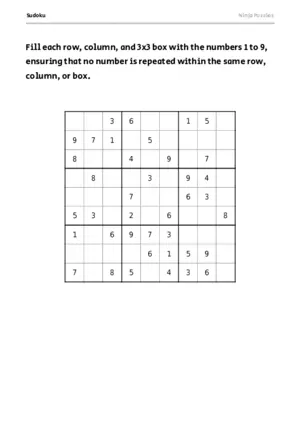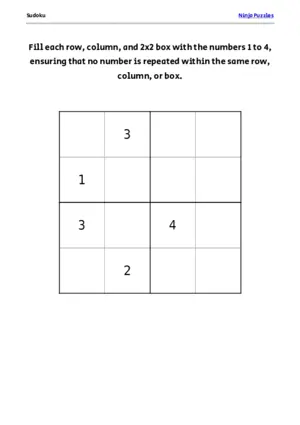Sudoku: X-Wing Strategy and Techniques
The X-Wing strategy is a powerful technique that can help you solve Sudoku puzzles more efficiently. It involves finding rows or columns where a specific number can only occur in two positions, and using this information to eliminate possibilities in other squares.
Here’s how the X-Wing strategy works:
- Choose a Number: Start by selecting a number that you want to apply the X-Wing strategy to. Look for numbers that have multiple occurrences in the puzzle grid.
- Identify Potential Rows: Examine each row and note down any rows that contain two or more occurrences of the chosen number.
- Identify Potential Columns: Similarly, look at each column and identify any columns that contain two or more occurrences of the chosen number.
- Find Matching Positions: Now, search for pairs of positions where the chosen number appears in both a potential row and a potential column. These positions should align with each other, forming an “X” shape when viewed on the puzzle grid.
- Eliminate Possibilities: Once you have identified an X-Wing pattern, you can eliminate all other occurrences of the chosen number in squares outside of the matching positions. This is because those squares must contain different numbers since they are part of different rows or columns involved in the X-Wing pattern.
- Update the Puzzle: After eliminating possibilities based on the X-Wing pattern, reassess the puzzle and repeat these steps for other numbers as necessary.
Here’s a handy tutorial explaining the strategy.
By utilizing the X-Wing strategy effectively, you can quickly narrow down possible numbers in various squares and make progress towards solving even challenging Sudoku puzzles.
Keep in mind that mastering this technique requires practice and experience with recognizing patterns within Sudoku grids. As you gain familiarity with spotting X-Wing opportunities, you’ll become more efficient at solving puzzles and enjoy greater success.
Sudoku Solver
If you get really stuck then we have an online Sudoku Solver, and a Sudoku Mini Solver to help you solve the most challenging Sudoku puzzles.
Advanced Sudoku Strategies
- Singleton Technique: This strategy involves identifying squares that have only one possible candidate number based on the numbers already present in the row, column, and box.
- Naked Pairs and Triples: When two or three squares in a unit (row, column, or box) have the same two or three candidate numbers, those numbers can be eliminated as possibilities from other squares in the unit.
- Hidden Pairs and Triples: This strategy focuses on identifying two or three candidate numbers that only appear in the same two or three squares within a unit. These numbers can then be eliminated as possibilities from other squares in the unit.
- Sudoku X-Wing: Sudoku X-Wing involves finding two rows or two columns where the same number can only occur in the same two positions. By eliminating that number as a possibility in the corresponding rows or columns, you can make further deductions.
- Swordfish: Similar to Sudoku X-Wing, Swordfish strategy expands the concept to three rows or three columns. It involves finding three rows or three columns where the same number can only occur in the same three positions, allowing for further eliminations.
- Sudoku Y-Wing: Sudoku Y-Wing is an advanced strategy that involves three cells and three numbers. By utilizing a specific pattern of candidate numbers, you can make deductions that lead to solving other squares.
- Sudoku XYZ-Wing: XYZ-Wing involves three cells and three numbers, with each number belonging to a different candidate list. It allows for deductions by creating chains of eliminations based on the relationships between the three numbers.
- Coloring: This strategy involves assigning colors (usually two) to candidates and using the relationships between these colors to make deductions.
- Backtracking: Backtracking is a brute-force technique that involves making educated guesses and trying different possibilities until a contradiction is reached or the puzzle is solved.








